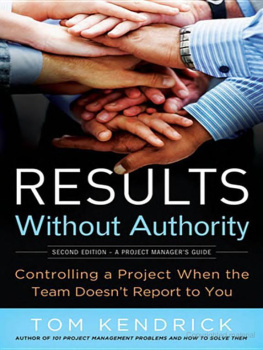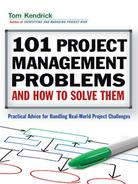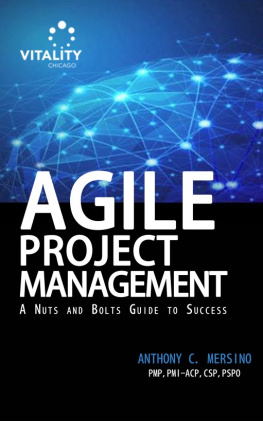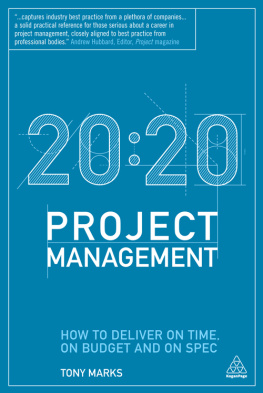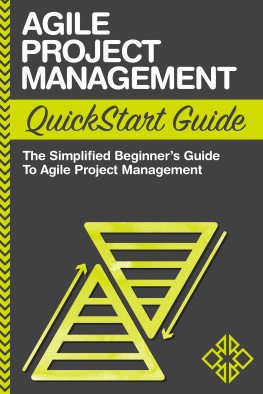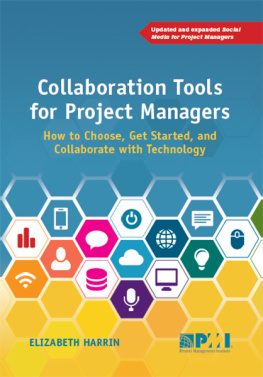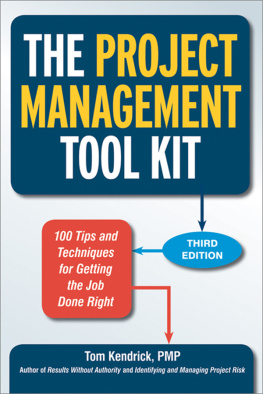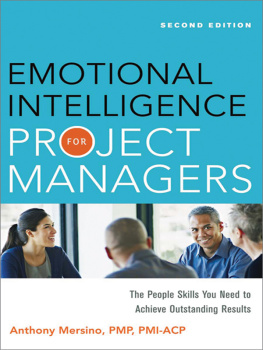Appendix B: Selected References
Although there are hundreds of books on project management, influence, and metrics, the few listed here are a good starting point for further exploration of the topics covered in this book.
Books on Project Management
Kendrick, Tom. The Project Management Tool Kit: 100 Tips and Techniques for Getting the Job Done Right , 2nd ed. AMACOM, 2010. Short process descriptions of essential project management processes.
Kerzner , Harold. Project Management: A Systems Approach to Planning, Scheduling, and Controlling , 10th ed. John Wiley & Sons, 2009. This sizable volume is thought by many to be the bible on project management.
Project Management Institute. A Guide to the Project Management Body of Knowledge , 4th ed. Project Management Institute, 2008. The PMBOK Guide is an overview of a wide range of project management topics. It provides a vocabulary and high-level descriptions but lacks specifics on what to do and how to do it.
Wysocki , Robert. Effective Project Management: Traditional, Agile, Extreme , 6th ed. John Wiley & Sons, 2011. A thorough book covering a range of project management approaches.
Books on Influence
Cialdini , Robert B. Influence: Science and Practice , 5th ed. Prentice Hall, 2008. A systematic exploration of how influence operates.
Cohen, Allan R., and David L. Bradford. Influence Without Authority , 2nd ed. John Wiley & Sons, 2005. A very complete and thorough book on exchange and reciprocity.
DeMarco , Tom, and Tim Lister. Peopleware : Productive Projects and Teams . Dorset House, 1999. Insightful essays on the human side of project management.
Englund , Randall, Bob Graham, and Paul Dinsmore . Creating the Project Office: A Managers Guide to Leading Organizational Change . Jossey -Bass, 2003. Thoroughly explores the process of effecting organizational changes using project management.
Pink, Daniel. Drive: The Surprising Truth About What Motivates Us . Riverhead Books, 2009. A good survey of traditional and current thinking on motivation in the workplace.
Books on Metrics
Austin, Robert D. Measuring and Managing Performance in Organizations . Dorset House, 1996. A useful book that explains why measurement so often leads to organizational dysfunction.
Grady, Robert B. Successful Software Process Improvement . Prentice Hall PTR, 1997. Describes using metrics for sustainable process improvements.
Kaplan, Robert S., and David P. Norton. The Balanced Scorecard: Translating Strategy into Action . Harvard Business Press, 1996. Defines a process for establishing a system of compatible business metrics.
Again, even when using weighted criteria for rank-ordering and selecting preferences, keep your eyes open and ensure that the outcome is acceptable and appropriate. A perfect decision that lacks support may lead to more problems than another option that your team feels better about.
Running a Successful Volunteer Fundraiser
Bob Montevaldo has been an experienced project manager in high-tech companies for many years. However, he recently found himself with a challenge while serving on the all-volunteer board of directors for Ombudsman Services, a nonprofit organization that serves the elderly in San Mateo, California. Recent tough economic times resulted in significant funding cutbacks for the organization, and the board decided that finding additional funding sources was necessary. At the time, Ombudsman Services was also celebrating its 30th anniversary, so an event combining an anniversary celebration with a fundraiser seemed like a good plan. As the board treasurer and resident project management guru, Bob offered to start investigating such an event.
Because the undertaking needed to raise funds, it had to be an entirely volunteer activity. Bob started by enlisting the help of several people who had a long history with Ombudsman Services to hash out ideas for the events theme, location, date, and budget. Bob documented all this in a proposal that he brought to the board for discussion. The board endorsed the proposed dinner dance concept at a local country club, and the event was approved for October, about 10 months away.
The initial group Bob had brought together had good chemistry, so he requested them to continue as the core team, each with specific responsibilities for the event. The group started meeting on a regular basis, and Bob reported their progress to the monthly board meetings. A key process Bob adopted early on was ensuring frequent communication between the board and the core team. Communication was essential because the commitment and enthusiasm of the board members were needed for obtaining auction items, securing sponsorships, and selling tickets. Bob also saw to it that the members of the core team had regular feedback from the board, and the team knew that they had continuing strong support from the board.
As the work proceeded, ideas flowed from the team to the board, and the board offered many helpful suggestions for the core team. (One board member even committed her husbands jazz band to play at the event, resulting in a significant savings.) Event planning moved forward quickly. Core team members took responsibility for sponsorship, program planning, ticket sales, event logistics, and the event auction, and Bob reported on their progress and accomplishments. Board members worked with the team to identify sponsorship prospects, solicit auction items, and make commitments for how many tickets they could sell.
As with any all-volunteer effort, there were some lapses and disappointments, but because of the overall visibility and clear documentation of assignments, they were rare. In the month prior to the event, there was much complicated activity, but the high level of communication that Bob had established paid off with commitments met and the continued enthusiasm of everyone involved. Many people even volunteered to do extra work.
One challenge the core team faced was that this was the first fund-raising event of its type that Ombudsman Services had ever done. With so little organizational experience, Bob knew that a few last-minute issues and problems were bound to come up. To deal with this possibility, just before the event he set up a walk-through with all the volunteers. In this exercise, they managed to find and fix most issues that they had missed.
The event was a great success; the ballroom was filled to capacity, and ticket sales and auction results exceeded their financial goals. Many attendees asked as they were leaving when the next dinner dance would be held. In addition, an important byproduct of the event was that it raised awareness of the organization within the community, especially with local politicians and businesses.
The final thing the core team did was to hold a postmortem to document things that went especially well, and areas that could be improved before the next event. All agreed that the key success factor was keeping all volunteers engaged through effective planning, communications, documentation, and monitoring of commitments.
Good processes always matter, and never more so than when everyone on the project is a volunteer.
Project Infrastructure
All projects have an infrastructure. Most have an infrastructure that is a combination of organizational standards and generally accepted defaults. Other projects have an infrastructure created by adding to or changing some key decisions that the project leader believes could materially help the current project. Establishing processes for your project sets a firm foundation for project control. Determining exactly how you apply these processes requires a framework of decisions for project planning, execution, and tracking. Documenting your decisions clarifies how you will operate and provides you with enhanced support for overall project control.

